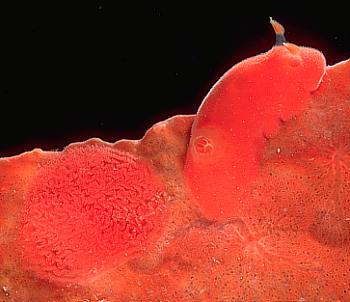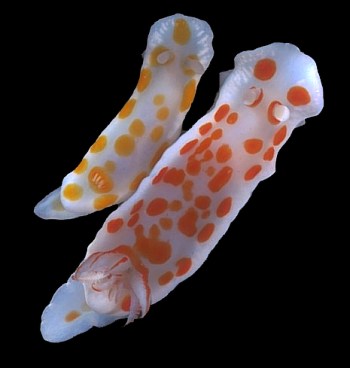

Colour in sea slugs
PHOTO
Upper: Rostanga bifurcata, (25mm long) with egg ribbon, on food sponge, Antho chartacea, AM C150065, Kurnell, Botany Bay, Sydney, May 1986. Lower: Chromodoris tasmaniensis, New South Wales colour form - Jibbon Head, Port Hacking, NSW, 20m, October, 1981, 21, 28mm long alive. Photos: Bill Rudman.
Sea slugs, especially the nudibranchs, are reknowned for their spectacular colour patterns but not all sea slugs are brightly coloured, and those that aren't should be equally famous for their amazing ability to disguise their presence with patterns, and precise colour, which accurately match the plants and animals colonies on which they live.
Have a look at the pages on Defence - Colour patterns, and Camouflage for further information on why colour is so important to sea slugs.
The very precise colour matches we find between many camouflaged sea slugs and their food is no coincidence. In most cases the slugs re-use the colour pigments of their food by incorporating them in their skin. A good example of this are species of the dorid genus Rostanga, such as Rostanga arbutus and Rostanga bifurcata which take the red pigments from their sponge food and incorporate in their skins, and apparently their eggs as well.
Another way of matching their colour with their food is found in the many spcies which have colourless, essentially transparent, skins. In these animals the gut often branches throughout the body cavity and in some cases through the the skin as well. The colour of their food then, becomes the colour of the slug. In special cases, such as the aeolid Favorinus, which feeds on other sea slug eggs, the colour of the slug is therefore dependent on the colour of the eggs it is eating.
Many of the sacoglossans, like Stiliger smaragdinus, get their colouring from the algal pigments they ingest, and the solar-powered nudibranchs which retain unicellular plants in their tissues are coloured by those plants.
Despite this widespread reliance on other plant and animal pigments, the majority of opisthobranchs manufacture their own pigments. A good example of this are the chromodorids which apparently generate the pigments which make their spectacular colour patterns.
Authorship detailsRudman, W.B., 2004 (July 25) Colour in sea slugs. [In] Sea Slug Forum. Australian Museum, Sydney. Available from http://www.seaslugforum.net/factsheet/colour
Related messages
-
More on flourescence
From: Alicia Hermosillo, August 13, 2007 -
Re: How do sea slugs make their colour?
From: Janine Cindy M. Santiago, August 5, 2006 -
How do sea slugs make their colour?
From: Janine C. Santiago, July 28, 2006
